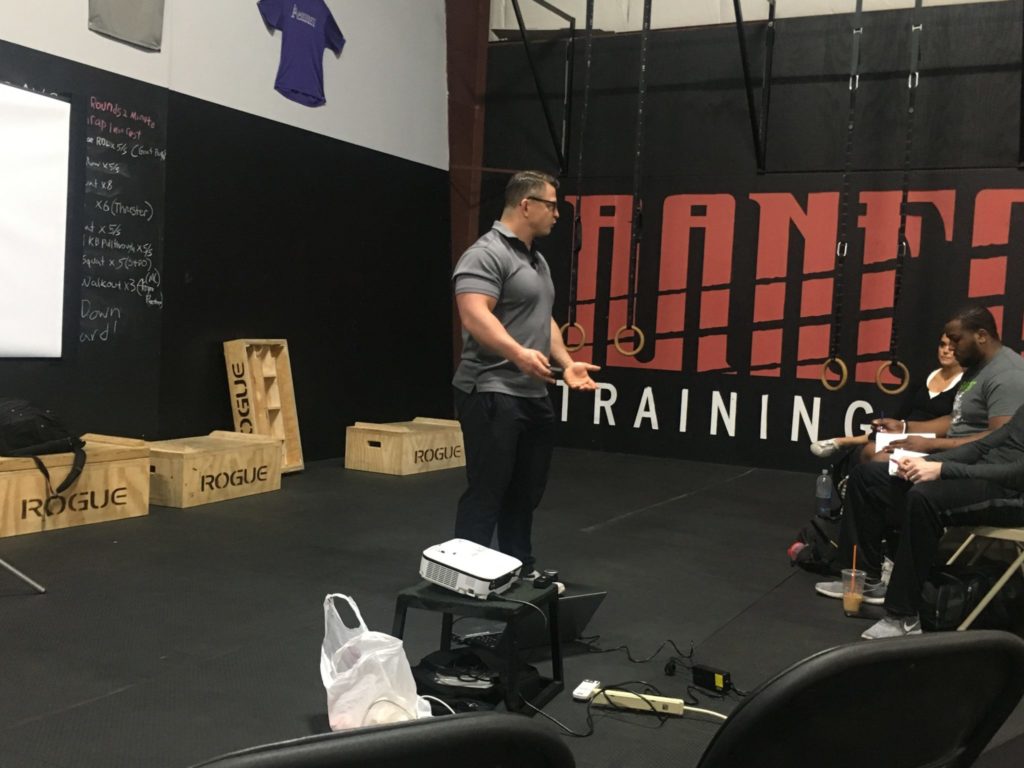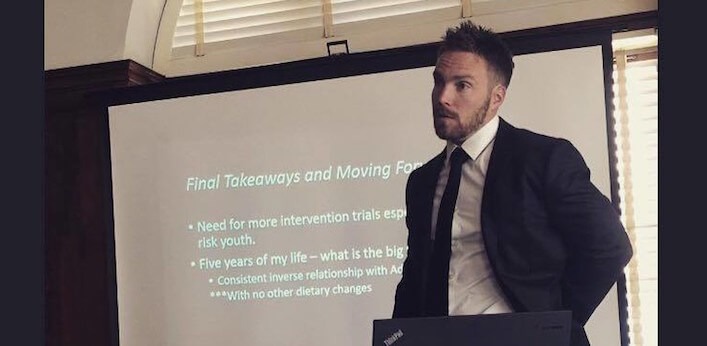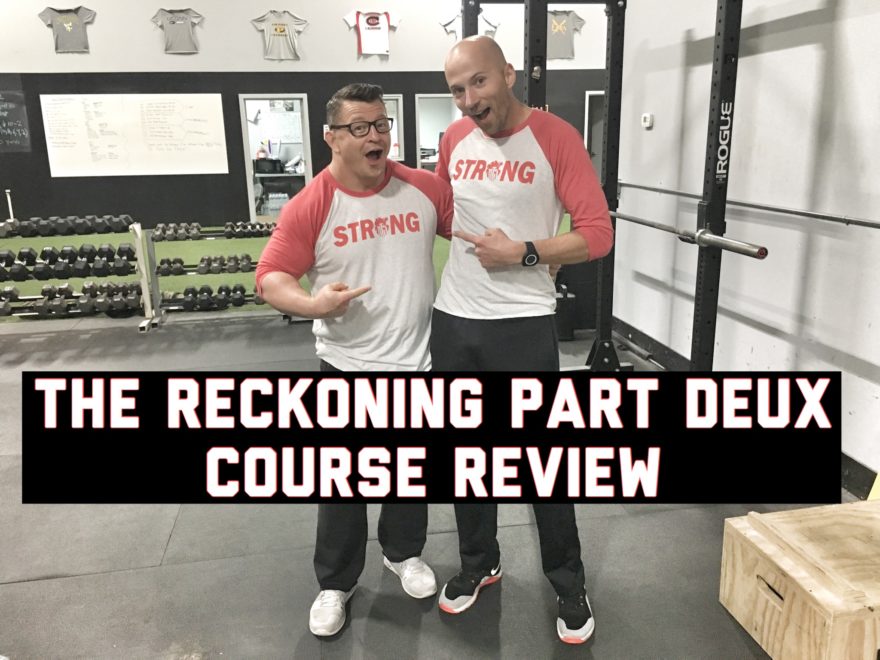I recently had the opportunity to attend The Reckoning: Part Deux, a course taught by Dr. Pat Davidson and Dr. Ben House. The host was my boi, Mike Ranfone.
This course focused on two concepts: understanding evolutionary history to influence programming (Pat’s talk), and discussing all things hypertrophy, fat loss, health, and nutrition (Ben’s talk).
I’ve heard Pat speak in the past, and always appreciate his drawing from many aspects of science to influence programming. His evolution discussion led to many light bulbs going off.

What had me really excited was to hear Ben speak. I have several colleagues who speak highly of his work, and given that nutrition/functional medicine is a weak point in my game, I wanted to hear his perspective.

Let’s just say, neither of the doctors disappointed. There was an excellent mix of theoretical and practical application, and both fellas approached performance from such different angles that the Reckoning as a whole was beyond comprehensive.
If you get a chance to hear either of these guys talk, sign up yesterday, you won’t regret it.
Table of Contents
Evolutionary Programming
Pat is one for laying out his model based on several different theoretical processes. While I’ve outlined some of those processes in my Pat Davidson’s Rethinking the Big Patterns Course Review, there were several other models that Pat expanded on that resonated with me.
The first model is variability, which is how the body changes shape to meet demands. This can be moving in an environment, personality, etc.
Variability requires more energy, more demand, and is a more complicated process than lack of variability. Greater complexity is likely more evolutionary existent than things of lesser complexity.
Complex and simple processes, and how they work in an organism, can be illustrated by the Jacksonian dissolution model. In this model, higher, more evolved brain centers inhibit earlier active brain areas. However, higher areas lose function in stressful situations. When stressed, lower brain areas take over because they are more efficient. Simple processes, well possessing less functionality, are much more reliable than complex processes.

Variability is a complex process in the body, whereas rigidity is simpler. The latter then, will be more readily utilized in stressful scenarios.
In our current environment, overall stress is much less. We do not have to worry about the sabertooth tiger attacking the camp. We don’t have to worry about famine wiping out our clan.
Instead, we are dealing with an artificial environment that creates minimal threat to our homeostasis. While this environment has increased our lifespan, it has worsened our health-span to the point where 50% of people over the age of 50 need medical assistance. This environment has made us less resilient, and more prone to many of the health problems we now face.
What kills us now is different than what did during hunter-gatherer times. The latter died from violence, accidents, and respiratory and GI infections. The diseases of modern times did not exist because we were appropriately stressed within our environment.
We are the only species who has switched lifestyles. Instead of hunting and foraging, we now farm in all ways. Not just food, but activity. Why should I jump if LeBron can do it for me? Sadly, we still have yet to evolutionarily figure out how to cope. What we’ve done to cope is develop modern disease.
Modern disease is an adaptation to our environment.
Because we are less adapted to stress, we are more prone to compensatory strategies, older systems, when threatened. If we compare our anatomy to that of chimps, the latter have anatomical orientations that bias back, hip, and thigh. A chimp pelvis is positioned into flexion, abduction, and external rotation such that those structures which are lateral on a human are posterior on chimps. This orientation creates side-to-side sway with ambulation.

The muscles that are biased on chimps are typically ones that we utilize when stressed. Is it no wonder these are common painful areas? Here we see us, under stress, reverting to older systems to manage the environment.
If we are less resilient to stressors, yet stuck in this artificial environment, what are we to do to survive? Our only hope is to either change the environment in some way, whether it’s the landscape of exercise or the literal environment.
Changing the Exercise Landscape
Pat focused on changing the landscape of exercise, and the key: make it stressful to make up for our stress deficit.
In order to keep things appropriately stressful and maintain client buy-in, we ought to first go after low-hanging fruits; qualities that improve quickly and easily. Fast results beget sustained buy-in. The easiest qualities to improve are slow speed strength and aerobic conditioning, and should be the focus early in any program.
Slow speed strength in particular is quite impactful even with improving high velocity movements such as sprinting. Slow speed and isometric strength are critical for initial acceleration. Because power is velocity-dependent, and acceleration begins without velocity, these strength qualities are best focused on to improve acceleration.

Surprisingly, strength is the biggest difference maker between being fast and slow. Pat mentioned a study which compared fast and slow runners. In both athletes, footspeed remained the same, but the difference maker was force application into the ground. Those who apply more force into the ground cover more distance. Slow speed strength helps improve force production.
Hypertrophy 101
Sarcopenic obesity.
These words might be the scariest pairing in the English language. A term that only exists because of the modern environment we are now in.
Sarcopenic obesity equates to having a combination of minimal muscle and maximal fat. If you fit these criteria, you are 3 times more likely to die. Considering the alarming rate at which muscle mass is lost past 50, likelihood of developing sarcopenic obesity is high.
Avoiding sarcopenic obesity is a must if you want to live a long time on this earth. Thus, having muscle mass (along with a high VO2 max and grip strength) is premium.
If muscle mass is important, we probably ought to know how to best put this on. Enter Dr. House, who told all that you need to know about hypertrophy.

There are a lot of misconceptions on how to best develop muscle. Ben laid out what which factors are the most important according to research.
Here are the four primary methods used to induce muscular hypertrophy:
- Muscular tension
- Metabolic stress (think bloodflow restriction training)
- Volume – shoot for 8-15 reps
- 13-19 sets per muscle group per week
- 40-70 reps per session, with a max of 210 reps per week
- Frequency – 2 times per week per muscle group, and this is the safest way to add volume.
When selecting hypertrophic modalities, know that they are not additive. You do not get a greater hypertrophy response by combining tension and metabolic training within session, so pick one or the other.
If the hypertrophy response is not moving in the direction you are liking, add more volume. Volume is the big equalizer, and the most important component to inducing hypertrophy.
Though volume is important, remember, we aren’t that resilient. We must dose stress properly and gradually. To effectively do this, we need to understand a few key terms:
Minimal effective dose: The least amount of work necessary to get results
Maximal adaptive volume: The most volume one can tolerate that leads to improvements
Maximal reserve volume: The most volume one can recover from but doesn’t necessarily mean the individual has improved.
Muscular hypertrophy requires pushing maximum adaptive volume as high as possible without reaching the reserve volume, and subsequent overtraining.
Knowing if the program is working requires measuring variables related to hypertrophy (muscle circumference, weights, pictures, etc). When measuring if a hypertrophy plan is working, timing is everything. You want to measure changes in weeks 4 and 16. The problem with results in the first 12 weeks from a hypertrophy standpoint is that you can appear “bigger” because of swelling from added volume. You want to minimize the noise from this variable.

Surprisingly, muscle damage, intensity, and hormones are not major hypertrophic contributors. In fact, muscle damage has been shown to decrease the hypertrophy response. As for intensity, various ranges have been shown to be effective for hypertrophy induction.
Hormones were the interesting piece. The hormone spikes that are associated with resistance training were not associated with increases in muscle mass.
We can see this point illustrated by comparing the sexes. Relative muscle mass gained on average by females and males is about the same (25# for females, 30-35# for males). Females may even tolerate volume better than males. Estrogen attenuates muscle damage, which allows females to train more frequently than males. Given the hormonal differences between the sexes, it seems as though hormonal responses from lifting are not that relevant.
The muscle gained from increased testosterone (approximately 100 ng/dL beyond an individual’s norm), say with drugs, allows for 1-1.5# of increased muscle mass without training. Thus, increased testosterone independently increases hypertrophy.
Does this mean that we should all be taking T? Depends on your goals. Sometimes, testosterone replacement therapy (TRT) is warranted. Many of the purported negative side effects from exogenous testosterone aren’t legitimate. There is no evidence to support increased cardiovascular disease risk, prostate cancer, or liver issues (as long as hematocrit is managed).
That said, TRT does have negatives. The first, is dependence. Because TRT decreases endogenous production, you will have to continue taking testosterone to maintain desired T levels.
People who are likely candidates for TRT would be concussion or testicular trauma, thus any pathology that would negatively impact testosterone production. Reason being is hypogonadism will cause muscle mass loss. From a morbidity/mortality standpoint, this is not good. TRT cannot be low dosed. Likely need 300-600ng.
Fat Loss 101
Once you’ve got them gainzzz, you’ve probably put on a little bit of chub. Time to obliterate the blubber and show off the fresh body armor you built. Enter Ben’s thoughts on fat loss.
Sustained fat loss is quite the challenge because it’s a direct battle with homeostasis. The body craves homeostasis, and in terms of energy, ideally what goes in should equal what goes out.
There are three keys to fat loss
- Adherence – Keep dietary changes slow and realistic to form good habits.
- Non-exercise activity thermogenesis (NEAT) – Movement throughout the day. For fat loss, shoot for 8000 steps
- Protein – The most satiating macronutrient. Shoot for 0.75g/pound. As for the other macros, go for 0.4g/pound of fat, and then fill the rest with carbs.
Though there are some macro recommendations above, low carb dieting may be helpful in the early stages of fat loss but not for why you think. We have 4-6# of water on board with 500g of glycogen. So if you go low carb and get rid of muscle glycogen, you’ll see quick success. Quick successes boost adherence to the long term game plan.
Once these major keys are in place, then ancillary keys can be focused on. Caloric deficit is one of these keys, and a must for fat loss over the long haul. Make sure that nutrient density is maintained as further deficits are pursued.

Once the deficit is in place, other keys such as increasing activity levels, self monitoring, and practice goal-oriented habits can be utilized to continue progressing.
Surprisingly, weight training is not as important for fat loss as you’d think. What it serves to do is help with muscle retention when in a calorie deficit, and prevent weight re-gain by encouraging healthy habits. The minimum training amount recommended to get these benefits is training two days per week.
Explain Blood Sugar
I learned a great deal from Ben on how blood sugar works. The best way to understand how it works is by looking at diabetics.

Diabetes deals with two key hormones—glucagon and insulin. Glucagon tells the liver to make sugar, whereas insulin inhibits glucagon. So if insulin cannot be produced, glucagon signals the liver to continually produce sugar, raising blood sugar levels and creating diabetes.
The two most prominent diabetes types are:
Type 1 diabetes (insulin deficient): can’t make insulin due to the immune system destroying beta cells
Type 2 diabetes (insulin resistance): Cannot use sugar or fat effectively. Cells cannot disperse glucose, blood sugar stays high because insulin cannot affect the cells.
Surprisingly, only 15% of diabetes is dietary related, and it seems like total calorie amount matters less than specific macros. If you compare low fat or low carbohydrate diets with similar calorie amounts, results on impacting diabetes are similar.
Muscles and mitochondria are key to develop if you have diabetes (sound familiar?). Insulin creation is mitochondrial dependent, and glucose is dispersed via muscle contraction. Combine the two, and you have a potent force in altering the diabetic landscape.
Understanding how blood sugar works does not just entail fasting glucose. You must also see how you respond to glucose. There is a poor-man’s version of an oral glucose tolerance test (OGTT) that you can perform.
After a high carbohydrate meal, measure your glucose levels at 30, 60, 90, and 120 minutes. Ideally, glucose should not go above 120. Levels above this value may signify carb intolerance and some insulin resistance. In these cases, decrease carbohydrate consumption and pick carbs you can tolerate. If you stay around 120 or less, you are likely insulin sensitive. Increase your carb consumption.
Sum Up
As you can see, the course was incredibly varied and comprehensive; a testament to the knowledge breadth that both Pat and Ben possess.
To summarize:
- We must add stress to our lives because our current environment does not threaten homeostasis
- Slow speed strength and aerobic conditioning are important improvable qualities to focus training on
- The biggest keys to hypertrophy are volume, frequency, tension, and metabolic stress
- Fat loss requires adherence, NEAT, and protein
- Muscle, mitochondria, and calories are key to diabetes management
What was your big takeaway from today’s post? Comment below and let us know!
Photo Credits


6 responses to “The Reckoning: Part Deux Course Review”
This summary was comprehensive AF. Thanks so much ZCup. You rock.
Glad you liked it my guy!!!
Awesome. So grateful to hear your takeaways from these two powerhouses. Thanks for digesting and articulating for the rest of us!
Appreciate you homegirl! 🙂
This is awesome. Wish I could have attended!
It was a great time. Wish you were there.